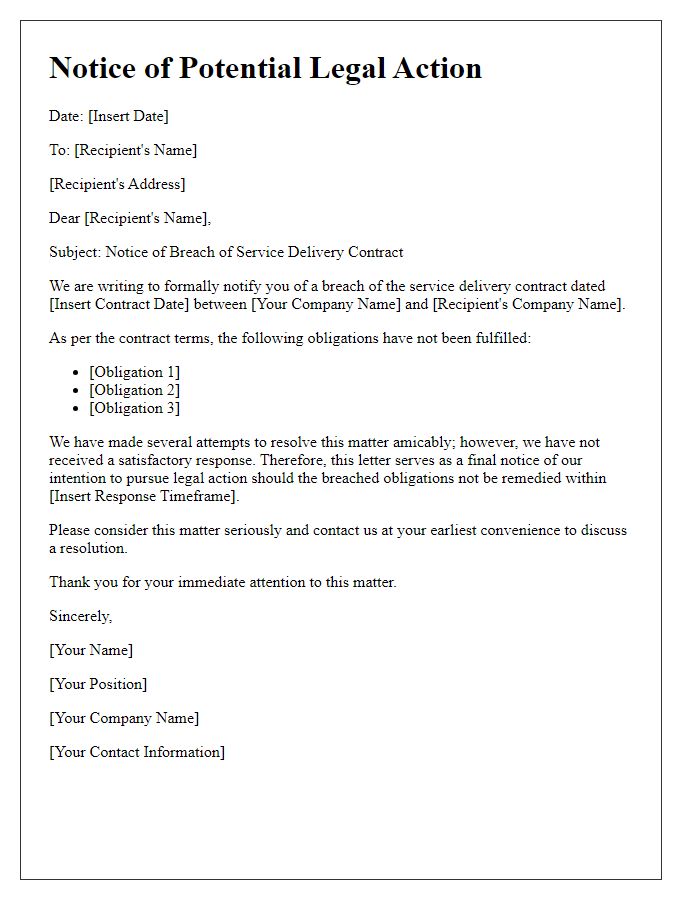Are you facing issues with a service provider not meeting their contractual obligations? It's frustrating when expectations aren't met, especially in business relationships built on trust and clarity. A well-crafted letter addressing a service delivery contract breach can help you formally express your concerns and seek resolution. Dive into our article for effective templates and tips to navigate this challenging situation with confidence!

Clear Identification of Parties Involved
In a service delivery contract breach scenario, clear identification of the parties involved is crucial. The parties typically include the Service Provider, an established entity responsible for fulfilling specific contractual obligations, and the Client, who engages the Service Provider for services such as consultation, maintenance, or delivery of goods. For instance, a service provider like Tech Solutions Inc., headquartered in San Francisco, California, may enter into a contractual agreement with a local business, Green Leaf Organic Grocery, for the regular supply of fresh produce. Each party should be accurately identified by their legal names, associated registration numbers, and addresses to ensure transparency and accountability in the contractual relationship, which is critical during any dispute resolution process. Additionally, any relevant representatives' details, such as a contact person's name and position, could further facilitate effective communication between the involved entities.
Detailed Description of Contractual Obligations
Service delivery contracts outline specific expectations for performance, including timelines and quality standards. Obligations may include timely completion of projects (e.g., within 30 days of contract initiation), adherence to safety regulations (such as OSHA standards), and maintenance of minimum service levels (like response times under 24 hours for customer inquiries). Providers may be required to submit regular progress reports (e.g., weekly updates) to ensure transparency. Failure to meet agreed-upon service standards can result in penalties, such as deductions from payment (often set at 5% of the invoice total for each week overdue), or potential termination of the contract if breaches remain unresolved beyond a specified notice period (typically 15 days for rectification). Keeping all communication documented is essential for establishing evidence of compliance or breach.
Specific Breach Incident with Dates
In April 2023, a significant service delivery contract breach occurred concerning XYZ Logistics, a prominent freight carrier in the United States. On the 15th of April, a shipment involving critical medical supplies for ABC Health, a healthcare provider based in New York City, was delayed by five days, violating the agreed-upon delivery window stipulated in the contract. This breach not only disrupted operations at ABC Health but also jeopardized patient care, leading to potential health risks. Furthermore, on the 22nd of April, subsequent communications regarding the rescheduling of the shipment were inadequately addressed, further compounding the issue. These incidents highlight a lack of adherence to the contractual obligations that XYZ Logistics must fulfill, necessitating immediate rectification to ensure compliance and mitigate future risks.
Consequences and Legal Repercussions
Breach of service delivery contracts can lead to various consequences and legal repercussions for the parties involved. Contractual obligations, such as timelines and quality standards, must be adhered to, with specific clauses addressing non-compliance. Failure to meet these obligations may result in financial penalties, which can vary greatly depending on the terms set forth in the agreement. For instance, companies may face liquidated damages, often defined as a predetermined amount calculated based on the extent of the breach or the project's total value. Additionally, affected parties might pursue legal actions, such as seeking restitution for losses incurred due to the breach, including lost revenue or additional costs. In severe cases, parties may seek termination of the contract, allowing them to mitigate further losses. Importantly, specific jurisdictions can impose particular legal frameworks, impacting how breaches are resolved and the remedies available, thus highlighting the significance of understanding local laws and regulations governing contractual agreements.
Request for Resolution and Next Steps
A service delivery contract breach can significantly impact business operations and client relationships. In such cases, documentation outlining the breach specifics is essential for effective resolution. Key elements include the contract date (specifying the original agreement established), the nature of the breach (such as delayed deliverables or substandard service quality), and the parties involved (including the service provider and the client). Additionally, references to specific clauses in the contract that have been violated will provide clarity. It is vital to propose clear next steps for resolution, such as setting a deadline for corrective action or outlining a meeting to discuss the issues. Including the date of the breach occurrence offers a timeline, while the request for written acknowledgment from the service provider reinforces accountability.
Letter Template For Service Delivery Contract Breach Samples
Letter template of formal complaint regarding service delivery contract breach

Letter template of request for rectification of service delivery contract breach

Letter template of demand for compensation due to service delivery contract breach

Letter template of notice for potential legal action over service delivery contract breach

Letter template of follow-up regarding service delivery contract breach resolution

Letter template of request for meeting to discuss service delivery contract breach

Letter template of amendment proposal following service delivery contract breach







Comments